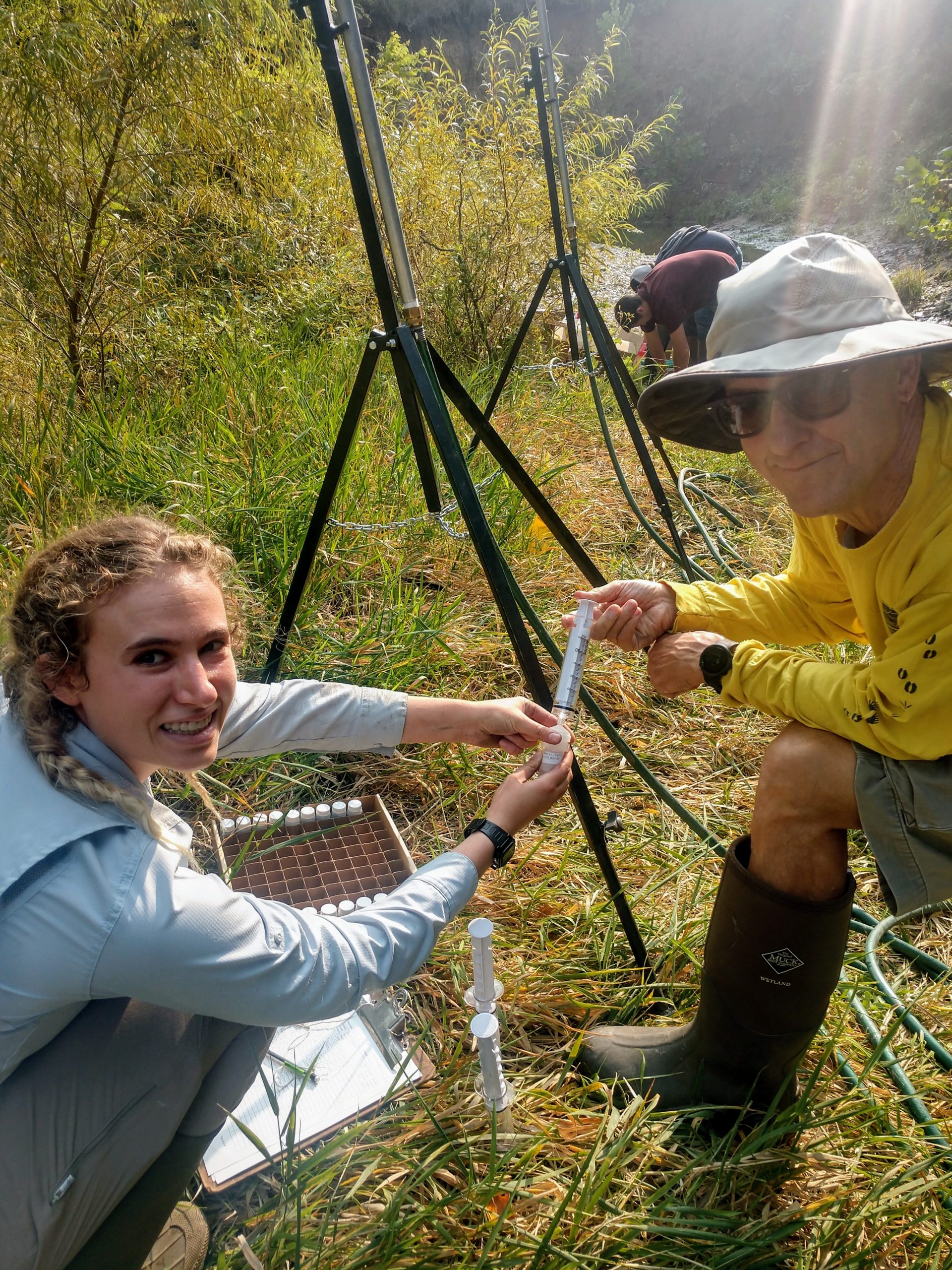
Dr. Walter Dodds and Gretchen collecting soil water from miniature lysimeters in the riparian zone before the rainfall simulation.
Monitoring rivers at a local preserve after joining the Watershed Environments and Ecology Lab was an influential factor that led to Gretchen Wichman’s interest in freshwater science. She said, “helping with hydrology monitoring at the Santa Lucia Conservancy and then leading the project a year later solidified my career goal to become a hydrologist for the United States Geological Survey (USGS).” Her research journey began in high school after members of the 500 Women in Science group connected her with a research lab at San Diego State University Coastal and Marine Institute, where she started assisting master’s students with their research. From this experience, she said, “I gained valuable research skills as well as mentors that assisted me with the college application process.” One master’s student she worked with advised her to go beyond the basic campus tour when visiting schools and ask to tour labs. So, when she visited California State University, Monterey Bay (CSUMB), she said, “I also visited with Dr. John Olson’s, Assistant Professor in Applied Environmental Science at CSUMB, and toured his Watershed Environments and Ecology Lab. During my visit, his students showed me how to rehydrate mosses from dry streams.” She explains, “That was when I knew I wanted to work in Dr. Olson’s lab and pursue an environmental science major concentrating in watershed systems.” The past three years working in the Watershed Environments and Ecology Lab has allowed Gretchen to be involved in several interesting research projects ranging from eDNA collection to detect amphibian species to assessing streamflow in the central Rocky Mountains.
Gretchen spent August, September, and October of 2020 working with Dr. Walter Dodds, University Distinguished Professor of Biology at Kansas State University (KSU) and Co-Pi for the Kansas NSF EPSCoR RII Track-1 Award OIA-1656006: Microbiomes of Aquatic, Plant, and Soil Systems across Kansas (MAPS). She also worked with James Guinnip, PhD Candidate in the Dodds Lab, as part of the MAPS Research Experience for Undergraduates (REU) program. She first met James at the 2019 Society for Freshwater Science conference following his presentation on “how nutrient export in intermittent streams is affected by characteristics of the dry period.” Gretchen said, “After chatting with James and following up months later, I accepted a summer research opportunity to work with Dr. Dodds and other collaborators on the MAPS project.”
The title of her project is Make it rain: Nutrient dynamics in the aquatic-terrestrial interface during simulated rainfall. The field method for Gretchen’s REU project was originally conducted by Brittany Kirsch for her master’s thesis at the University of Nebraska-Lincoln. Dr. Jessica Corman and Dr. Andrea Basche advised Kirsch’s research. The idea came about for an REU project when Dr. Walter Dodds listened to Dr. Corman’s seminar about Kirschs’ work. Dr. Corman spoke about “making it rain” over the riparian zone in streams flowing through agricultural and restored prairie landscapes. Kirsch detected a pulse of nitrate, ammonium, phosphorus, and suspended sediments in the stream channel. A bromide tracer was used to account for the pulse of added water from the simulated rainfall. Gretchen’s REU project is based on Kirsch’s field experiment. She even used the same rainfall sprinklers that Kirsch designed.
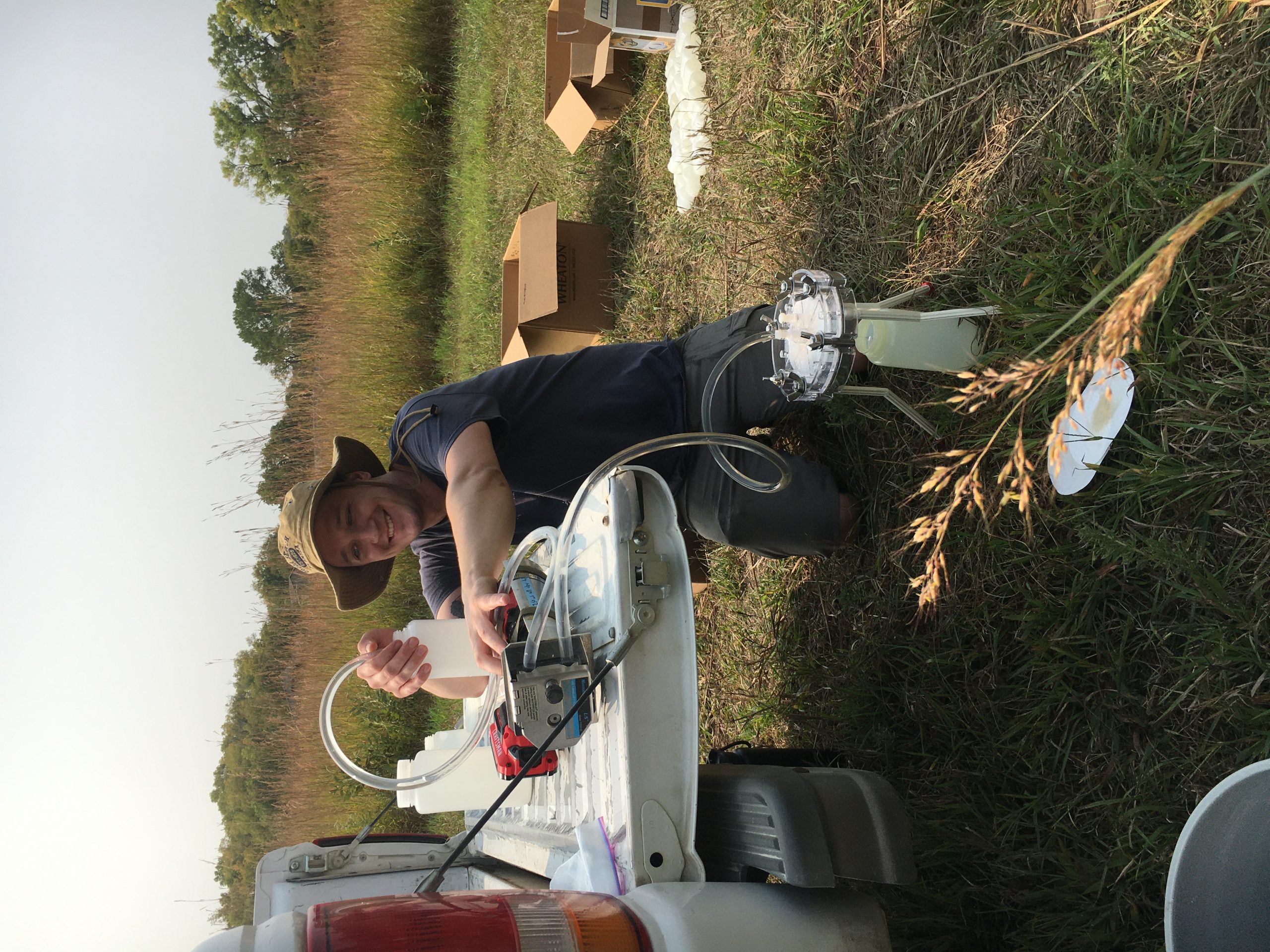
James Guinnip, Ph.D. candidate in the Dodds Lab filtering stream water samples for dissolved nutrient analysis.
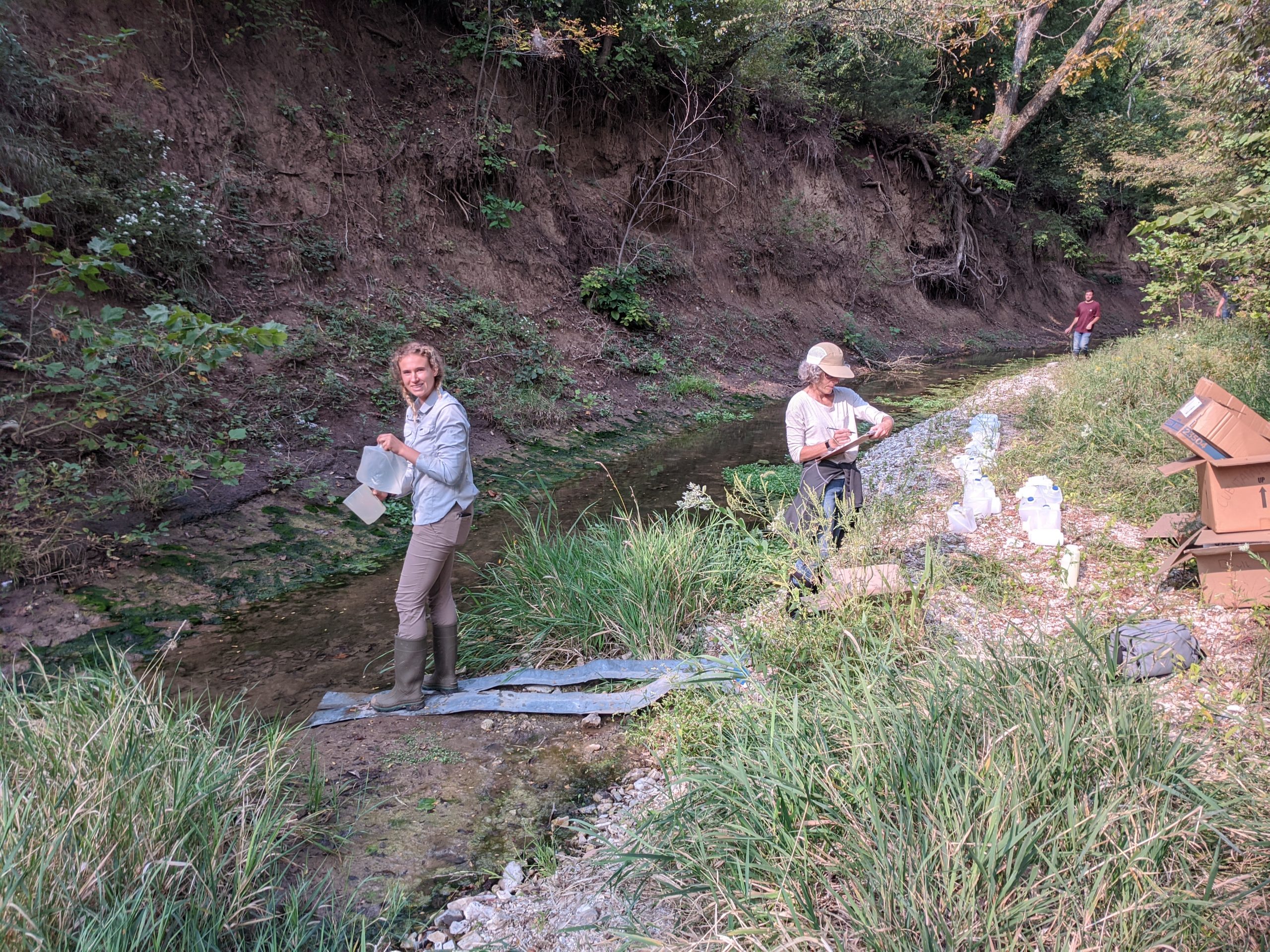
Gretchen sampling stream water for nutrients, ions, and isotope analysis.
Gretchen describes the motivations for her MAPS REU project as “Riparian corridors provide ecosystem services such as protecting water quality by retaining nutrients. We know that the disruption of riparian zones can lead to more nutrients entering freshwater systems. However, we do not have clear ideas of what determines the capacity for nutrient retention/release in streams and their associated riparian zones. Integrating knowledge of ecosystem function in streams and riparian zones will provide a more comprehensive understanding of riparian corridors. ”
The field method has stream water and riparian sampling components, she recalls, “Dr. Dodds, KSU researchers, and I ran a rainfall simulation experiment over the riparian zone at Kings Creek. Our rainfall event was about 2.5 inches for 1.22 hours with a 6.4 x 3.2 m rainfall footprint. We used deionized spring water as our “rainwater”. We added 15NO3- isotopic tracer and NaBr conservative solute to our “rainwater” to trace hydrologic flow paths and nitrogen uptake.
Stable isotopic tracers like 15N are differentiated from 14N which has a substantially greater natural abundance in nature. The conservative solute and the isotopic tracer allowed us to tell the difference between our rainwater in the stream and the pre-existing stream water. Plus, we could follow the fate of the added nitrate. We sampled stream water 21.7 m upstream of the release, 8.5 m downstream, and 68 m farther downstream. We sampled stream water over a time course to characterize nitrogen uptake in the stream channel and the riparian zone. We evaluated the role of riparian uptake and transport by sampling soil cores and soil moisture before and after the simulated rainfall. Riparian grasses were sampled to determine whether the 15N label was incorporated into the grass biomass. This sampling regime allowed for the assessment of hydrologic flow paths. It also tracked the movement of material transport (i.e. nutrients, ions, and suspended sediments) from the riparian soils to the stream channel.”
The lab methods were completed by many people. She said, “Shaun Baughman and I used the LINX II protocol to extract and measure dissolved 15NO3- in the sampled stream water. Shaun processed riparian soil and grass samples for subsequent isotopic and other chemical analyses. Lane Lundeen helped by filtering the water samples for determination of suspended sediment concentrations. Analytical chemistry labs processed the water samples for nutrient and ion concentrations.”

Dr. John Blair collecting soil samples using a soil corer and me recording
the depth and location of the soil cores.
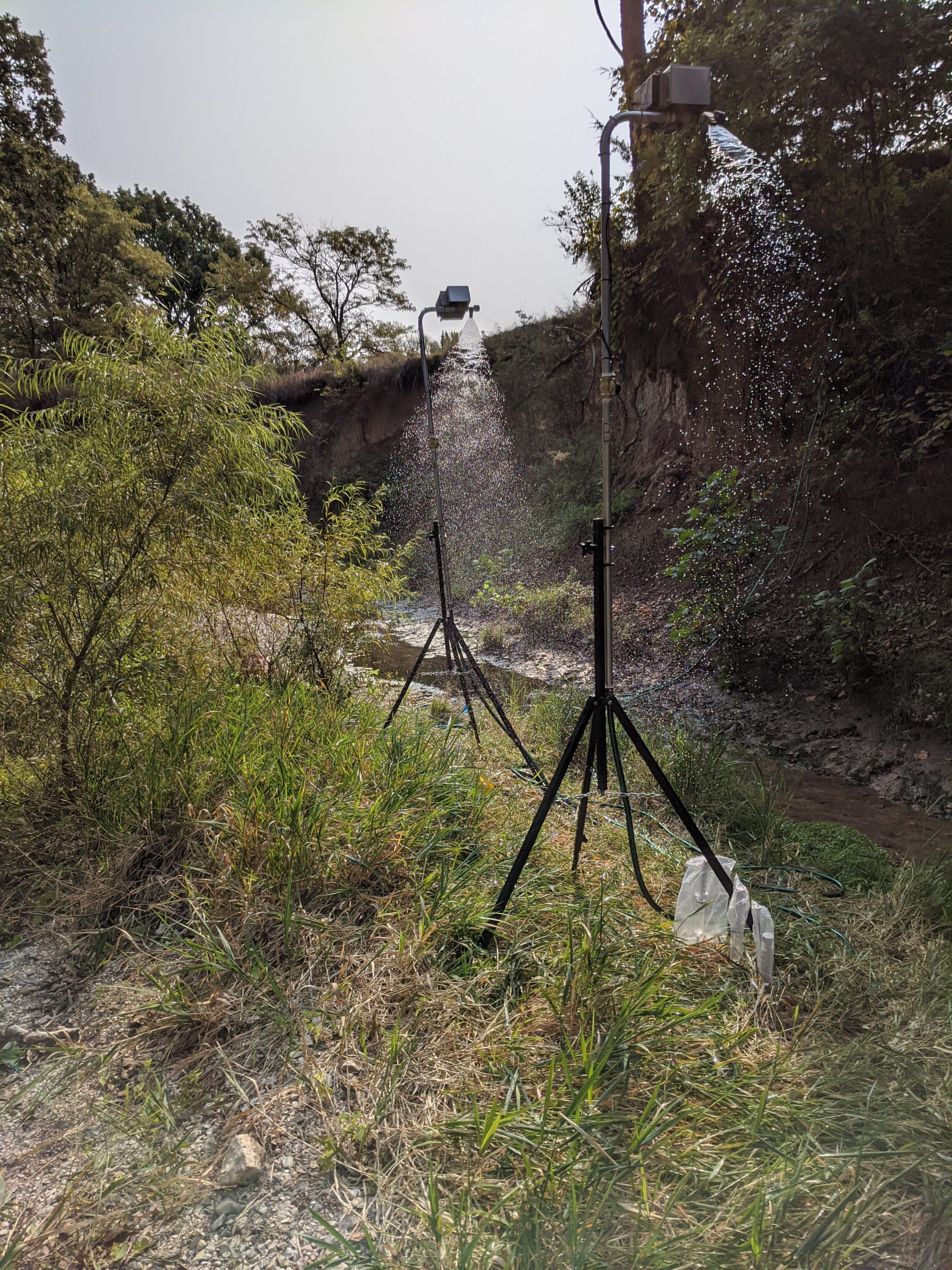
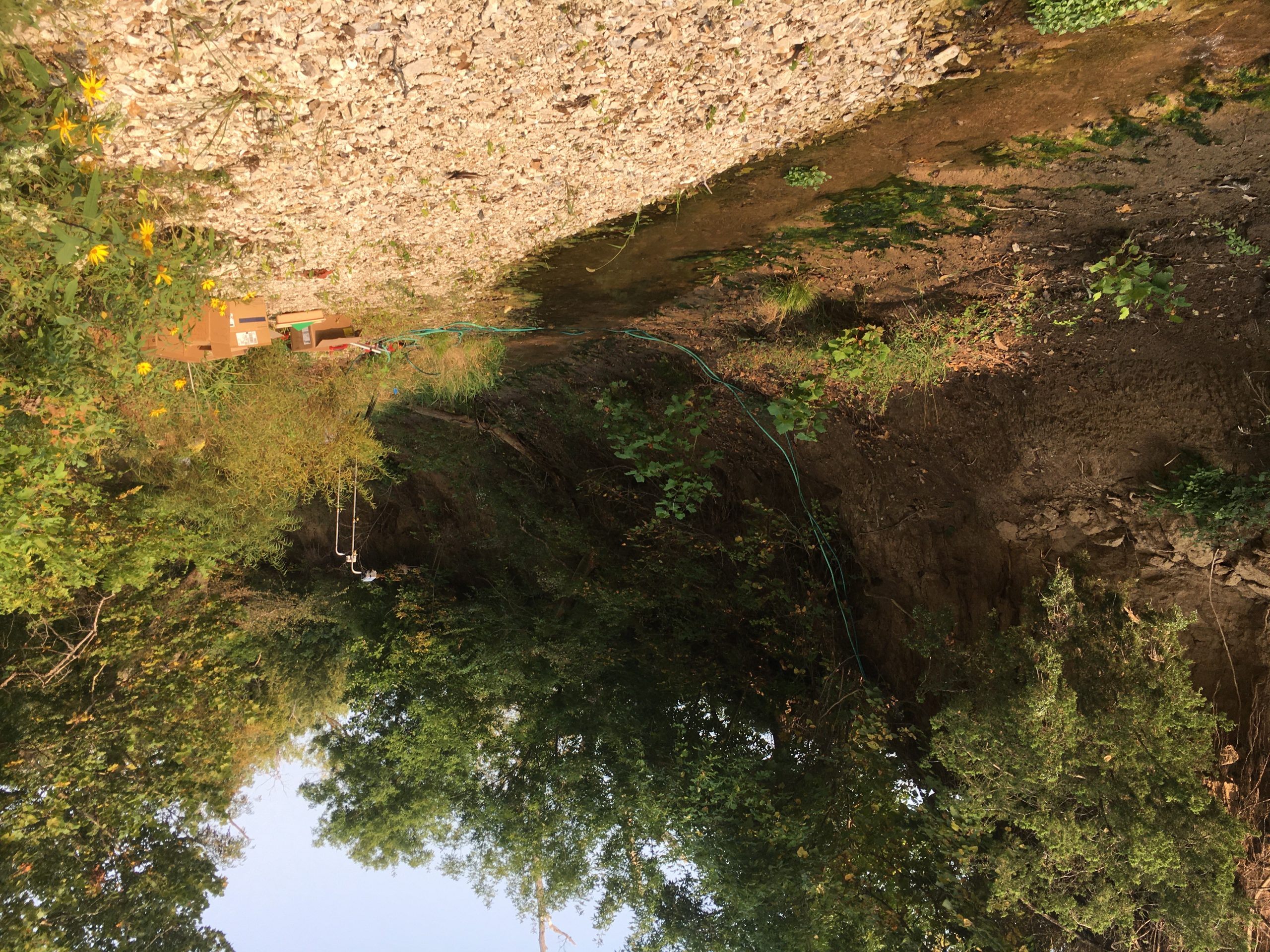
Rainfall simulation experiment over the riparian zone at Kings Creek on the Konza Long Term Ecological Research (LTER) Station.
Gretchen explains the early results and how it compares to Kirsch’s results, “The flow paths of the simulated rainfall did travel through the riparian zone and into Kings Creek! Although we detected 15NO3- and NaBr in the stream channel, we did not detect a pulse of nitrate, chloride, sulfate, fluorine, or suspended sediments. The pulse of sodium bromide traveled from the riparian zone and into the stream in about 9 minutes and then traveled downstream 60 m in about 40 minutes. Conversely, Kirsch’s experiment did detect a pulse of nitrate, ammonium, phosphorus, and suspended sediments. One reason we may have observed different results could be that Kirsch’s sites were in an agriculturally influenced watershed while our site was in a prairie dominated watershed on the Konza LTER. This project will further the understanding of the role that riparian vegetation plays in trapping nutrients and sediment to protect water quality. These results suggest that the strength of the riparian-stream connections is related to land use.”
The rain experiment was Gretchen’s favorite part of her research; however, it was the sense of community and support involved in the planning and execution of the project that she enjoyed the most. She said it was exciting to be able to collaborate with nine field team members including Dr. Walter Dodds, Dr. John Blair, James Guinnip, Dolly Gudder, Anne Schechner, Molly Fisher, Justin Brisendine, Alex Wohler, and Lane Lundeen. She continued, “Months of planning whirled into action with many helping hands at each station. Patrick O’Neal and Jim Larkins with the Konza LTER helped me troubleshoot equipment issues and we couldn’t have gotten this project off the ground without them.” Thus, she felt she was a part of the research community at the Konza LTER.
When asked what she learned from her experience, she said, “prior to visiting Kansas State University, I had little experience doing lab work. Usually, the only time I was in the lab was to find field gear. However, while working in the Dodds Lab, one protocol I learned was the Lotic Intersite Nitrogen eXperiment (LINX II) protocol for extracting and measuring isotopic enrichment of dissolved inorganic nitrogen. Simply adapting to daily lab work proved to be a steep learning curve, she added.
Gretchen also mentioned she “learned how to plan a large-scale experiment with over 500 anticipated samples with coordinating data forms, custom-made sprinklers, a portable deionization system, 250-gallon tank, and other moving parts. As a result of my REU experience, I not only gained lab work skills but also gained an understanding of the endurance required to complete a research project. These new skills will be useful for working towards developing a thesis during graduate school.”
Gretchen virtually presented her REU project at the CSUMB Undergraduate Research Opportunities Center (UROC) Summer Research Symposium in August 2020 and at the Great Plains Limnology Conference in October 2020. She plans to present a virtual poster at the MAPS Research Symposium in March 2021, and her project has been featured on the Society for Freshwater Science headwaters blog and Instagram.
Originally from San Diego CA, Gretchen is in her third year at CSUMB and plans to graduate in the Spring of 2022. She is an Undergraduate Research Opportunities Center (UROC) Scholar which involves preparing for graduate school and conducting undergraduate research with her UROC mentor, Dr. John Olson. Her independent capstone research project involves investigating the influence of salinity on leaf breakdown rates in tidal streams. In addition, she has received the Bob Curry Watershed Scholarship, the Society for Freshwater Science Instars Award, the Florence Riford Scholarship from the Rotary Club of La Jolla, the Yukon and Clemence Chow Scholarship, the Brian Graves Memorial Scholarship, the Margaret Jane Anderson Memorial Scholarship, the San Diego Metropolitan Credit Union Scholarship and the Dean’s List Honor. While working as an Undergraduate Researcher in the Watershed Environments and Ecology Lab at CSUMB, she has participated in the following research projects: 1.) Streamflow duration assessment in the central Rocky Mountains for the Environmental Protection Agency (EPA), July 2020; 2.) Ecological monitoring of the Carmel River following dam removal and river reroute, June 2020; 3.) Hydrology monitoring for the Santa Lucia Conservancy, Fall 2018 – Present; and 4.) Environmental DNA (eDNA) collection to detect amphibian species for the Department of Defense (DoD), Spring 2019. Her foundation for research started in high school while serving as a research assistant at the Marine Conservation Ecology Lab at San Diego State University Coastal and Marine Institute.
Outside of research, Gretchen said, “I enjoy surfing lesser known reefs near my home in San Diego and near my university in Monterey. When I moved north for college, I was introduced to cold water surf and subsequently a thicker wetsuit! Periodically returning home, I am reminded of how special the coastline is in San Diego. During my time off from school, I continue to explore point breaks in southern and central California.” She also volunteers “with the Sage Garden Project by assisting the garden and nutrition educator with virtual lessons including interactive Kahoot activities based on the weekly content. For example, one Kahoot activity was about the difference between sowbugs and pillbugs in soil communities.” The lessons support the curriculum for the Sherman Elementary School students that are learning English as a second language. She enjoys her volunteer work because she is able to contribute to classroom content about soil communities and growing food in gardens.
Once Gretchen graduates in the Spring of 2022, she said “I would like to earn a master’s in environmental science to support my career goal of becoming a hydrologist for the USGS. In Fall of 2022, I plan to begin a master’s program to develop a thesis that will inform river management in coastal watersheds. My REU experience has motivated me to learn more about riparian corridors and how to better manage them.” The most eye opening component of her REU experience was visiting the KSU biology department and the Konza LTER. She wants to continue to visit new places to conduct freshwater science research. She is interested in attending graduate school in Queensland or New South Wales, Australia to engage in an international research network.
